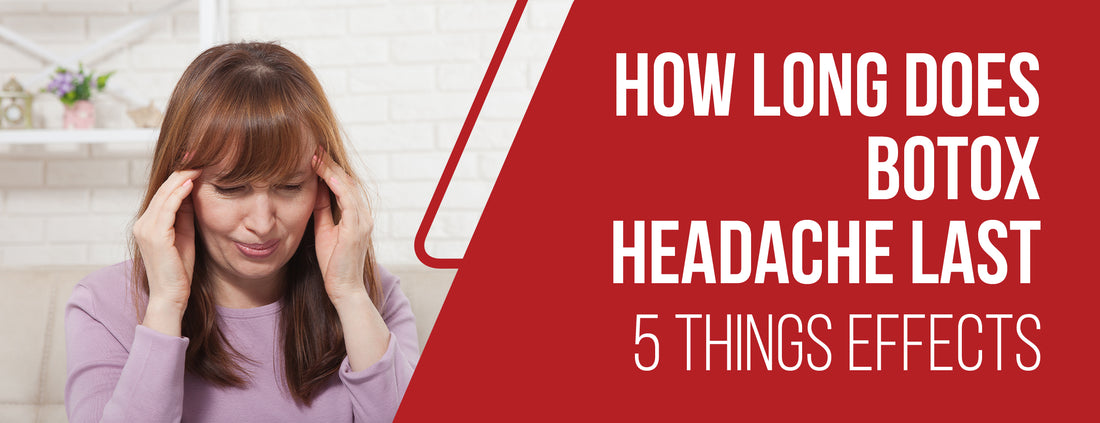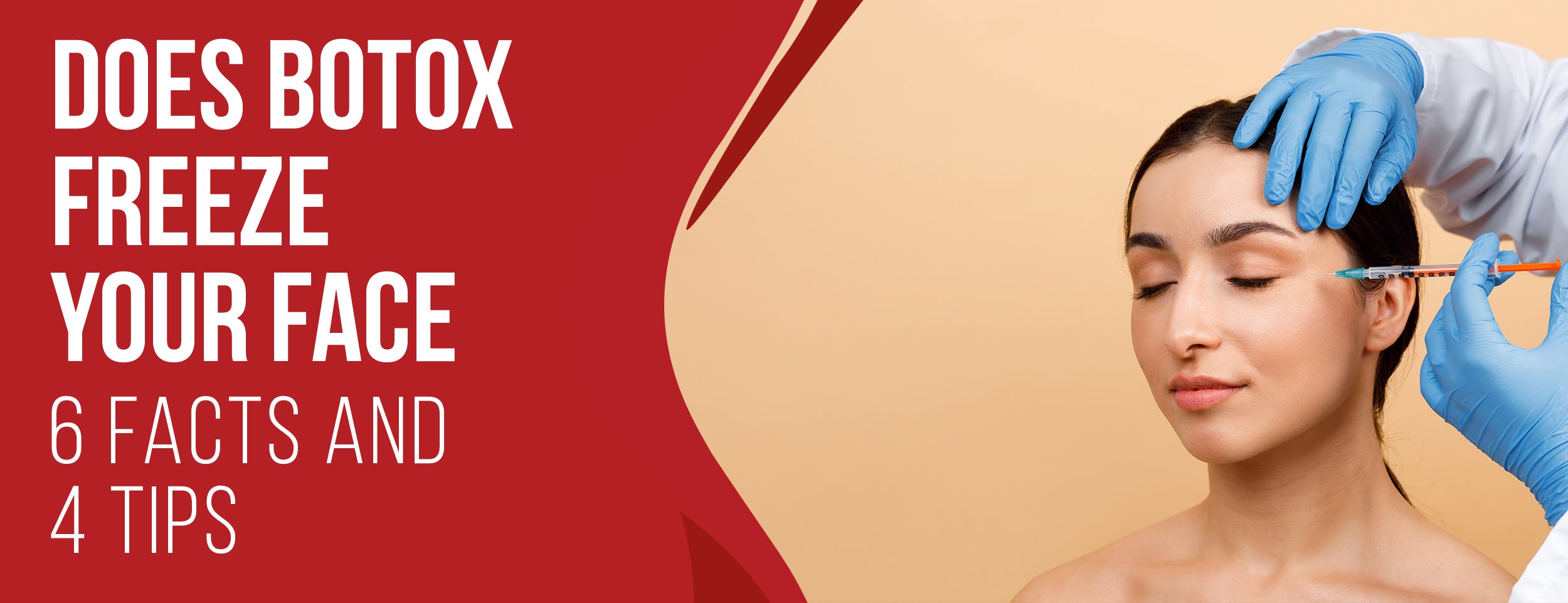An injection of Botox, which reduces fine lines and wrinkles, is a popular cosmetic treatment. One of the side effects that some people experience after receiving Botox injections is a headache. While Botox-induced headaches are usually temporary, their duration can vary based on several factors.
The headache is a result of the injection itself, and it is typically described as a mild to moderate tension headache. Most patients experience the headache within 24 to 48 hours after botoxing the injection, lasting up to two weeks. Some patients may experience a headache for up to one month.
This blog post explores how long a Botox headache typically lasts and what you can do to prevent or relieve it.
How Long Does Botox Headache Last: 5 Factors

The duration of Botox-induced headaches can vary from person to person due to a range of factors. After Botox injections, some people experience longer-lasting headaches, while others find relief more quickly.
Dosage of Botox Injection
Botox dosage affects how long associated headaches may last during treatment. There is no correlation between higher doses and longer-lasting headaches; the right dosage balance tailored to each patient matters. Factors to consider include:
- An appropriate and personalized dosage can contribute to a more effective treatment outcome, minimizing the potential for extended headaches.
- Striking the right balance between a therapeutic dose and an excessive one can significantly influence the treatment's duration and effectiveness.
Location of Injection Site
The precise location where Botox is injected also influences the duration of headaches. Various areas of the face and neck are targeted to address specific concerns, and the choice of injection site can impact the headache duration:
- Proximity to Pain Source: Injections targeting trigger points directly related to headache pain might lead to quicker relief, potentially shortening the duration of headaches.
- Muscle Relaxation: Botox works by relaxing muscles injections in areas contributing to headache tension could alleviate pain sooner.
- Patient Sensitivity: Patients might experience varying durations based on how their body responds to injections in specific locations.
- Spread of Botox: The diffusion of Botox from injection sites varies, potentially affecting the coverage of pain-relieving effects.
Frequency of Botox Treatments

The frequency at which Botox treatments are administered can influence how long the associated headaches persist. Establishing a suitable treatment schedule is essential for managing potential headaches:
- Antibody Build-Up: Frequent Botox treatments, closer than every three months, may lead to the development of antibodies against botulinum toxin.
- Cautionary Approach: The three-month interval is maintained to minimize the risk of antibody formation and ensure the continued effectiveness of Botox in headache management.
- Balancing Act: This approach balances headache relief and avoids potential complications associated with more frequent injections.
- Medical Guidance: Always consult with a healthcare provider to determine the most suitable treatment frequency based on personal needs and considerations.
Botox treatments for headaches are typically administered every three months, following the recommendation by the American Headache Society.

Medical Conditions And Medications
People with certain medical conditions or those taking specific medications might experience varied durations of Botox-induced headaches. Medical factors that can influence headache duration include:
Medical Conditions:
- Chronic Migraine: Botox is prescribed primarily for adults with chronic migraine, characterized by experiencing 15 or more headache days per month, each lasting four or more hours.
- Each person's Variability: A person's overall health and pre-existing medical conditions can influence the duration of Botox headaches.
- Underlying Sensitivity: Some medical conditions might make patients more prone to experiencing prolonged or intensified post-Botox headaches.
Medications:

- Interaction Effects: Certain medications a person takes might interact with Botox and influence the duration and severity of post-treatment headaches.
- Blood Thinners: Medications like blood thinners can impact the body's response to Botox, potentially affecting the duration of associated headaches.
- Pain Medications: The use of pain-relieving medications, especially around the time of the Botox procedure, could impact the experience of post-treatment headaches.
- Discuss with Healthcare Provider: Providing information about medications to healthcare providers will ensure a comprehensive assessment of potential interactions.
Effects of Botox on People
Each person's unique physiology and response to Botox injections contribute significantly to how long headaches might last:
- Positive Impact on Chronic Migraines: Botox treatments have demonstrated a reduction in the frequency of headache days per month, particularly for chronic migraine sufferers, compared to placebo.
- Delayed Onset of Effect: The effects of Botox treatment might not be immediate. It's commonly observed that it takes 10 to 14 days after the injection for the results to begin taking effect.
- Gradual Reduction in Headache Frequency: As Botox starts to work, patients often experience a gradual decrease in the frequency and severity of headaches over time.
- Botox Variation: Botox can have a different effect on different people. It may take some people to feel relief, while it may take longer for others.
- Cumulative Effect: With successive Botox treatments, the benefits tend to accumulate, resulting in more consistent and lasting relief from chronic migraines.
- Consultation with Healthcare Provider: Patients need to consult their healthcare provider to set realistic expectations and to understand how Botox could impact their specific condition and headache patterns.
Botox treatment seekers and medical professionals can work collaboratively to minimize associated headache duration by considering these influences.

Types of Headaches Caused By Botox
Botox injections have different effects on headaches; not all headaches are caused by the treatment. These headaches can vary in severity, characteristics, and how long they persist. Patients who undergo Botox injections for various reasons can benefit from understanding these distinctions.
Mild To Moderate Headaches
One category of headaches that people might experience after Botox injections falls within the mild to moderate intensity range. These headaches are typically characterized by:
- Type of Headache: Headaches can be a potential side effect following head, neck, or facial Botox injections.
- Severity: Fortunately, these headaches are typically mild to moderate in intensity.
- Management: Over-the-counter pain medication can effectively soothe and alleviate these headaches.
- Temporary: The headaches are usually temporary and tend to subside as the body adapts to the Botox treatment.
- Response Varies: People's responses may vary, with some people experiencing only mild discomfort while others might have slightly more noticeable symptoms.
Migraine-Like Headaches

Another category of headaches triggered by Botox injections shares similarities with migraines in terms of symptoms and intensity. These migraine-like headaches exhibit the following characteristics:
- Pain Quality: The pain is often described as throbbing or pulsating and can be accompanied by moderate to intense discomfort.
- Duration: Migraine-like headaches usually last two weeks to a month, unlike milder headaches.
- Associated Symptoms: People experiencing these headaches might encounter heightened sensitivity to light, sound, and even odors. Nausea and, in some cases, vomiting could also be present.
Migraine-like headaches don't necessarily indicate a pre-existing migraine history. Botox injections can trigger these headaches even without prior migraine experiences.
Frequency And Duration of Headaches
The frequency and duration of headaches following Botox injections can vary widely based on patients' responses and factors such as the specific treatment area and dosage. Here's a general overview:
- Frequency: Mild to moderate headaches might occur infrequently and sporadically, often in the immediate aftermath of the injection.
- Duration: After several months, nerves may sprout new pain fibers, leading to the return of headaches.
- Migraine-Like Headaches: These headaches can be more prolonged, potentially lasting several days. The Botox effect typically provides relief for about 2½ months.
- Cumulative Effect: As Botox injections are administered no sooner than every three months, some patients may require alternative headache treatments during the last two weeks of a Botox cycle. With subsequent Botox injections, the frequency and intensity of headaches might decrease as the body acclimates to the treatment.

Conclusion:
A Botox headache is a common side effect of the cosmetic treatment, but it is typically temporary and easily treated. While the headache can last up to two weeks, most patients experience it for only a few days. If you experience a severe headache or any other unusual side effect after the injection, it is important to contact your doctor immediately.
Weigh the potential benefits of Botox versus the risks before using it to treat wrinkles or migraines. Consult your doctor to determine if Botox is the right treatment option.











